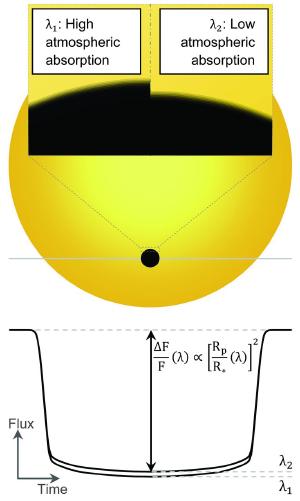Blog
Air Apparent
3 January 2014
There are now more than 1,000 confirmed exoplanets. The majority of these planets have been found by the Kepler telescope using what is known as the transit method. The transit method looks at stars over long periods of time, measuring any changes in the brightness of the star. If a planet passes in front of the star (transits), then the star will appear slightly dimmer. From this we know a planet orbits the star.
The main downside of this method is that it requires the planet’s orbit to be along our line of site so we can observe it transit the star. But if that happens to be the case, then we can gather a wealth of information about the planet. By measuring the time between transits we can determine the orbital period of the planet, from which we can determine its orbit. By measuring how much the star dims, we can determine the size of the planet relative to its mass. We can even learn things about the atmosphere of a planet by observing how it filters the star’s light.
One thing we haven’t been able to determine from a planetary transit is the planet’s mass. During a transit, the star is dimmed in proportion to the planet’s size relative to the size of the star. Knowing the temperature and brightness of a star we can get a really good measure of the star’s size, and from that we can determine the size of the planet. But size is not the same as mass.
We can make a rough estimate of a planet’s mass from its size. If a planet is about the size of Neptune, for example, then it probably has about the same mass. But the mass of a planet depends upon its size and its density. A high-density planet will have more mass than a low density planet of the same size. And density matters when it comes to planetary makeup, since a rocky planet will have a higher density than an icy or watery one.
For some transit planets we have other information, such as the Doppler motion of the star, and from this we can determine the mass of a planet. But from transit observations alone we haven’t been able to determine mass… until now.
A new paper in Science has outlined how transit data can be used to determine the mass of a planet directly.1 The method relies on the fact that the a planet’s atmosphere (actually what’s known at it’s pressure profile) depends upon its surface gravity (which depends on size and mass). The effect of this pressure profile can be observed in the transit data, as seen in the image below.
 De wit J, Seager S., from their paper
De wit J, Seager S., from their paperOf course the pressure profile also depends upon the planet’s temperature and the density of the atmosphere, so to take these into account the team drew upon the work of 18th century mathematics. It turns out all these parameters are connected by a constant known as Euler–Mascheroni constant. This constant plays a central role in the way an atmosphere’s temperature, density and pressure profile affect light passing through the planet’s atmosphere.
Of course this idea is fine in theory, but to prove it works you need to compare the mass of an exoplanet determined by this new method with the mass determined by traditional means. The authors did just that with an exoplanet known as HD 189733b. From Doppler methods, the mass of this exoplanet is known to be 1.14 Jupiter masses. Using this new method, the authors got a mass of 1.15 Jupiter masses. We’ll want to do similar comparisons with other exoplanets, but it seems clear this method works really well.
This method has a huge potential, because future exoplanet telescopes, such as the James Webb telescope scheduled to be launched in 2018, have all the necessary equipment to make these kinds of measurements. This method doesn’t require any fancy new equipment, simply an analysis of data we already planned to gather.
de Wit, Julien, and Sara Seager. “Constraining exoplanet mass from transmission spectroscopy.” Science 342.6165 (2013): 1473-1477. ↩︎